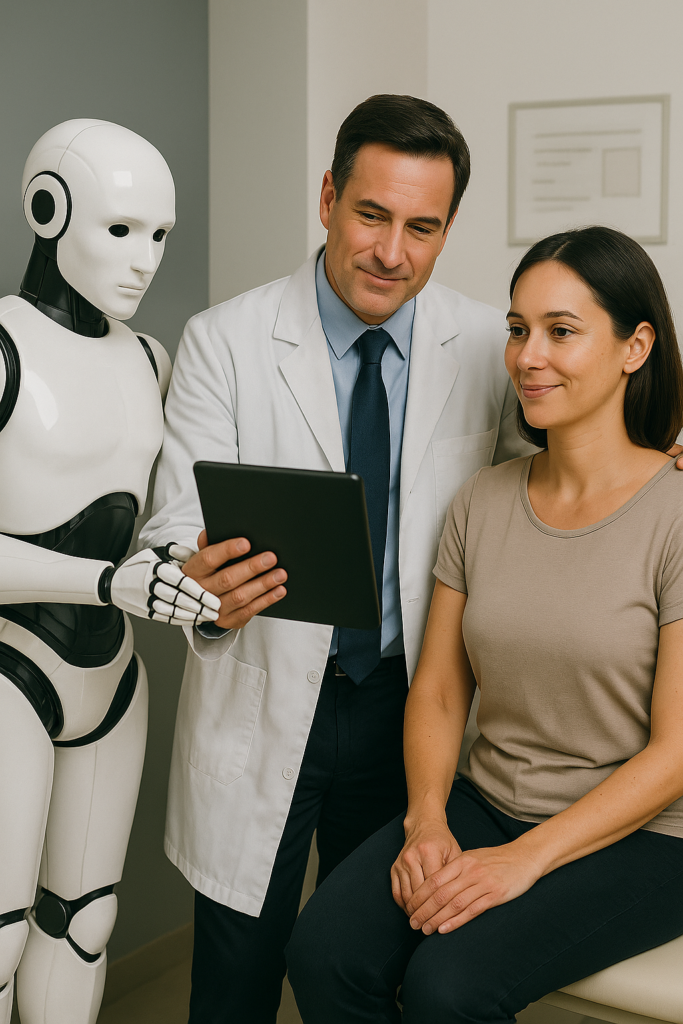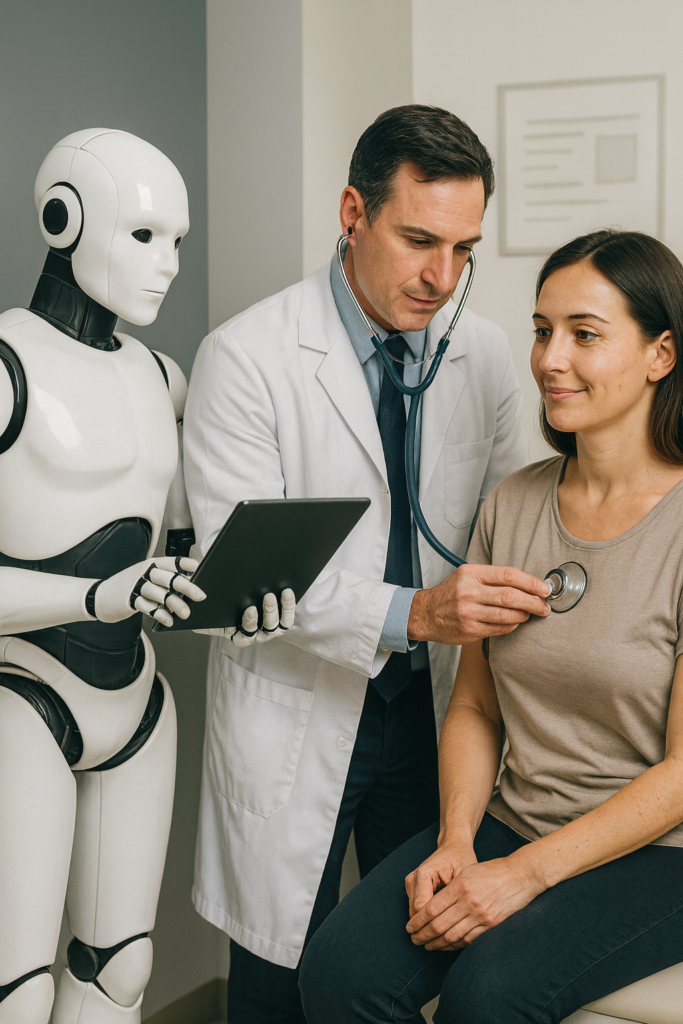
In the digital age, healthcare is undergoing a seismic transformation. From AI diagnostics to robotic surgeries, wearable devices to remote patient monitoring, the integration of advanced technologies is improving accuracy, access, and efficiency like never before. However, as we lean into automation and algorithms, an essential question emerges: Can we preserve the human touch in healthcare amid rapid technological advancement? And even more provocatively — will AI replace doctors?
This blog explores the benefits of advanced technology in healthcare, the problems with technology in healthcare, and the crucial need to balance innovation with compassion. Because while machines may process data faster than any human, only a human can truly understand another.
Benefits of Technology in Health Care
The benefits of technology in health care are undeniable. From improving operational efficiency to saving lives through faster diagnosis, here’s how technology is transforming the healthcare landscape:
1. Faster, More Accurate Diagnosis
AI-powered tools help detect conditions like cancer, stroke, or retinal disease earlier and more accurately. Machine learning algorithms can analyze medical images or lab reports far quicker than the human eye.
2. Real-Time Patient Monitoring
Wearables and mobile apps allow continuous monitoring of vitals like heart rate, oxygen saturation, or glucose levels. Patients with chronic conditions can be observed remotely, reducing hospitalizations and improving lifestyle management.
3. Greater Access Through Telemedicine
Technology bridges gaps in care by reaching rural and underserved communities through teleconsultations. It enables patients to access specialists without the need for travel—saving time, money, and sometimes lives.
4. Improved Workflow and Documentation
Electronic Health Records (EHRs) streamline clinical documentation and reduce paper-based errors. With AI integration, EHRs can even suggest next steps, flag drug interactions, or alert about patient deterioration.
5. Personalized Treatment Plans
Using big data and genomics, healthcare providers can now create treatment plans tailored to an individual’s medical history, genetics, and lifestyle—making care more effective and precise.
Also read- Healthcare Data Security Challenges | Critical Threats
AI Technology and Patient Care: Striking the Right Balance
While technology has revolutionized healthcare, it should enhance, not overshadow, the core of healing: human touch. The rise of automation must be matched with intentional efforts to preserve compassion, communication, and emotional support in care delivery.
This harmony of AI technology and patient care is the key to future-ready, people-centered medicine.
Examples include:
- AI summarizing EHRs so doctors can focus on patients during visits
- Virtual assistants managing post-discharge check-ins, freeing up nurses
- Digital tools reminding patients of medications while doctors build relationships
The goal? Let technology handle the logistics, and let caregivers handle the healing.

Will AI Replace Doctors in Maintaining Technology and Patient Care? The Debate Heats Up
AI’s role in healthcare is rapidly expanding. Algorithms are now diagnosing diseases, analyzing scans, predicting health risks, and even managing patient flow in hospitals. Tools like IBM Watson, Google’s DeepMind, and ChatGPT’s medical applications have demonstrated AI’s potential to support—and in some cases outperform—human decision-making in narrow tasks.
But the idea that AI will replace doctors is more myth than reality.
While AI can assist with symptom checks, detect patterns in medical images, and even suggest treatment protocols, it lacks the emotional intelligence, ethical reasoning, and nuanced judgment that define human clinicians. Healthcare is not just about curing diseases — it’s about understanding fears, building trust, and comforting pain, all of which require empathy and a deep human connection.
In reality, AI is not here to replace doctors, but to augment their capabilities, reduce administrative burden, and allow them to focus on what truly matters: the patient.
Also Read- Scientific Discoveries That Changed the World in a Bad Way
AI Technology and Patient Care: Benefits of Advanced Technology in Healthcare
The integration of digital tools into healthcare has led to remarkable improvements in both clinical outcomes and operational efficiency. Some key benefits of advanced technology in healthcare include:
1. Improved Diagnosis and Early Detection AI Technology and Patient Care
AI algorithms can analyze vast datasets in seconds, detecting anomalies in imaging or lab reports that even trained professionals might miss. This leads to earlier diagnosis and improved treatment outcomes, especially in cancers, retinal diseases, and cardiology.
2. Enhanced Patient Monitoring
Wearable tech like smartwatches, glucose monitors, and fitness trackers enable real-time tracking of vitals. This allows doctors to monitor chronic conditions remotely, reducing hospital visits and improving patient autonomy.
3. Telemedicine and Remote Access
Technology has expanded care beyond hospitals. Telehealth platforms connect doctors to patients in rural or underserved areas, breaking down geographic barriers and improving access to care.
4. Streamlined Operations
Electronic Health Records (EHRs), AI-based scheduling, and digital billing have significantly reduced administrative work, minimizing errors and allowing clinicians to devote more time to patient care.
5. Personalized Treatment Plans
Genomics, AI, and big data allow for treatments tailored to individual patient profiles. Personalized medicine is becoming a reality, improving drug efficacy and reducing side effects.
Also Read- Alternative Medicine for Pain & ADHD | Natural Solutions
AI Technology and Patient Care: Problems with Technology in Healthcare
Despite its promise, healthcare technology comes with critical challenges that must be addressed to ensure safe and ethical care.
1. Depersonalisation of Care
As screen time increases, face-to-face interactions between doctors and patients may decline. Patients often feel like they’re talking more to computers than to caregivers, risking a sense of disconnection and reduced satisfaction.
2. Data Security Risks
The more digital our healthcare systems become, the more vulnerable they are to cyberattacks. A breach of patient data not only violates privacy but can disrupt care delivery and erode trust.
3. Technology Dependency
Overreliance on machines can dull clinical instincts. There’s a risk of clinicians becoming overly dependent on digital tools, potentially overlooking patient cues that aren’t captured in data.
4. Health Inequity due to Technology and Patient Care
Access to technology is not uniform. Low-income patients, older adults, or those in rural areas may not have access to smartphones, internet, or the digital literacy to navigate modern systems, increasing the digital divide in care.
5. Burnout from Tech Overload
Ironically, while EHRs were designed to save time, they often burden healthcare workers with excessive data entry. This can contribute to clinician burnout — already a growing crisis in the industry.
Human Touch Technology: Can They Coexist?
The rise of AI and automation has sparked a growing conversation around human touch technology — the idea that digital tools should support, not replace, compassionate care. Tools must be designed with empathy in mind, serving both the clinician and the patient.

What does this look like in practice?
- AI that summarizes medical records so doctors can maintain eye contact with patients.
- Virtual assistants that handle routine follow-ups while humans deliver serious news.
- Robots that assist with repetitive physical tasks, allowing nurses more time for emotional care.
- Telehealth platforms with embedded emotional intelligence features—tone recognition, patient mood tracking, etc.
In short, when technology is implemented thoughtfully, it frees up humans to do what only humans can do—connect, listen, and care.
Also Read- How to strengthen mind body connection | Effective Techniques
Why We Still Need the Human Touch in Healthcare with Technology and Patient Care
The human touch is not just a poetic ideal, it’s a medical necessity. Countless studies have shown that empathy improves patient outcomes, increases treatment adherence, and enhances trust.
A reassuring hand, a compassionate word, or even just undivided attention can calm fears and boost healing. In palliative care, mental health, maternity, and even intensive care units, emotional support is just as critical as medical intervention.
Technology can assist in clinical tasks, but it can’t comfort a grieving family, understand cultural sensitivities, or navigate moral dilemmas. These aspects of care demand human presence—heart, not just code.

Creating a Balanced Future: Technology + Empathy
To create a resilient, patient-centered healthcare system, we need both technology and empathy. Here are ways healthcare organizations can strike this balance:
- Design for People First: Choose tools that enhance—not hinder—face-to-face interaction.
- Train for Tech + Compassion: Teach healthcare workers both digital fluency and emotional intelligence.
- Involve Patients: Involve users in designing systems that are intuitive, accessible, and sensitive to real human needs.
- Measure What Matters: Go beyond efficiency metrics. Track patient satisfaction, emotional support, and clinician well-being.
- Foster Cross-Disciplinary Teams: Bring together engineers, clinicians, patients, ethicists, and designers to co-create healthcare innovations.
Moving Forward: Building a Compassionate Digital Future Along with AI Technology and Patient Care
To truly unlock the potential of modern medicine, we must integrate AI technology and patient care in a way that prioritizes compassion, equity, and trust.
Strategies for Success:
- Design patient-first tech that is easy, intuitive, and empathetic
- Train healthcare workers in both digital skills and bedside manner
- Include patients in developing solutions they will use
- Focus on outcomes beyond metrics — measure emotional experience too
Healthcare will always need the human touch. Technology is a tool — not a replacement, but a partner in care.
Also Read- Holistic Health & Healing | A Complete Guide to Natural Wellness
Final Thoughts
So, will AI replace doctors in order to achieve AI technology and patient care? No. But it will reshape how doctors work, helping them become faster, better-informed, and more available for human connection.
The key is not to resist technology but to integrate it thoughtfully, preserving the human touch in healthcare that machines can never replicate. As we build the healthcare systems of tomorrow, let’s ensure that compassion, dignity, and empathy remain at the core, with technology as a powerful partner, not a replacement.
Because healing isn’t just about data. It’s about being seen, heard, and cared for.
Want to know more about the recent AI technology and patient care details? Stay connected with us or subscribe to our blog now!
References
- Beyond Algorithms: Why Healthcare Needs Both Technology and Human Touch – ShiftMed
- World Health Organization – Digital Health
- NIH – Artificial Intelligence in Medicine
- HealthIT.gov – Benefits and Risks of Health IT
- Forbes – Will AI Replace Doctors?
